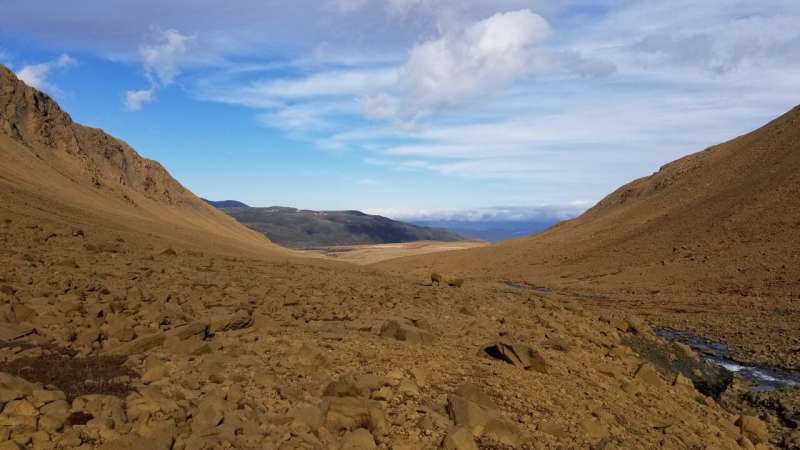The rim and floor of Gale Crater as seen from NASA’s Curiosity Rover. Courtesy of NASA
The question of whether there has ever been life on Mars has intrigued scientists and the general public for decades. At the heart of this discovery is gaining insight into the past climate of Earth’s neighboring planet. Was Mars warm and wet, with oceans and rivers like Earth’s? Or was it frigid and icy, and not suitable for supporting life as we know it? A new study finds evidence to support the latter, by identifying similarities between Martian soil and the soil of the Canadian island of Newfoundland, which has a cold sub-Arctic climate.
the study, Published in Communication Earth and the Environment, They searched for soil on Earth that contained materials similar to those in Gale Crater on Mars. Scientists often use soil to Environmental HistoryThe minerals present tell the story of how the landscape has changed over time.
A better understanding of how these materials formed could help answer long-standing questions about Mars’ historical conditions: Gale Crater’s soils and rocks are a record of a climate 3 to 4 billion years ago when Mars was relatively water-rich, the same time that life first emerged on Earth.
“Gale Crater is an ancient lake bed and clearly had water in it. Environmental condition “Do we know what it was like when there was water on Mars?” says Anthony Feldman, a soil scientist and geomorphologist now at DRI. “The conditions on Mars are so different from those on Earth that we’ll never find a direct analogue on the Martian surface, but we can look at trends under Earth conditions and apply them to problems on Mars.”
NASA’s Curiosity rover has been exploring Gale Crater since 2011 and has found large amounts of soil material known as “X-ray amorphous material. ” These soil components lack the typical repeating atomic structure that characterizes minerals and therefore cannot be easily characterized by traditional techniques such as X-ray diffraction.
For example, when a crystalline material like diamond is hit with X-rays, the X-rays scatter at characteristic angles based on the mineral’s internal structure. X-ray amorphous materials, however, do not produce such a characteristic “fingerprint.” This X-ray diffraction technique was used by the Curiosity Rover to demonstrate that soil and rock samples tested in Gale Crater are composed of 15-73% X-ray amorphous material.
“X-ray amorphous materials are like jelly,” Feldman said. “Jelly is like a soup of different elements and chemicals that slide around one another.”
The Curiosity rover also performed chemical analysis of soil and rock samples, finding that the amorphous material is rich in iron and silica and deficient in aluminum. Beyond the limited chemical information, scientists still don’t understand what the amorphous material is or what its presence suggests about Mars’ historical environment. Uncovering more information about how these enigmatic materials formed and persist on Earth could help answer long-standing questions about the Red Planet.
To search for similar X-ray amorphous material, Feldman and his colleagues visited three locations: the plateau of Gros Morne National Park in Newfoundland, the Klamath Mountains in Northern California, and western Nevada. All three locations contain serpentinite soils that the researchers predicted would be chemically similar to the Gale Crater X-ray amorphous material in that they are rich in iron and silicon and deficient in aluminum.
The three locations also recorded ranges of rainfall, snowfall and temperatures, which could help provide insight into the types of environmental conditions that produce amorphous material and promote its preservation.

Research site on the Newfoundland Tablelands. Photo credit: Anthony Feldman/DRI
At each site, the team examined the soil using X-ray diffraction analysis. Transmission electron microscopy,They are soil Analysis of the material at a more detailed level. Newfoundland’s subarctic environment produced materials that were chemically similar to those found in Gale Crater, but lacked the crystalline structure. Mild climate This is not the case in California or Nevada.
“This tells us that water is needed there to form these materials,” Feldman says, “but to preserve the materials, the average annual temperature has to be cold, close to freezing.” Amorphous Materials Into the soil.”
Amorphous materials are often considered to be relatively unstable, meaning that at the atomic level, the atoms have not yet organized into a final crystalline form.
“There’s something going on in the kinetics, or reaction rates, that slows down the reactions so that these materials are preserved over geological timescales,” Feldman said. “What we’re suggesting is that very low temperatures, close to freezing, are the specific kinetic limiting factors that allow these materials to form and be preserved.”
“This study improves our understanding of the Martian climate,” Feldman added. “The results suggest that the abundance of this material in Gale Crater is consistent with subarctic conditions similar to those found in Iceland, for example.”
For more information:
Anthony D. Feldman et al. “Iron-rich X-ray amorphous material records past climate and persistence of water on Mars” Communication Earth and the Environment (2024). Publication date: 10.1038/s43247-024-01495-4
Provided by
Desert Research Institute
Quote: Mars was likely cold and icy in the past, new study finds (July 10, 2024) Retrieved July 11, 2024 from https://phys.org/news/2024-07-mars-cold-icy.html
This document is subject to copyright. It may not be reproduced without written permission, except for fair dealing for the purposes of personal study or research. The content is provided for informational purposes only.


